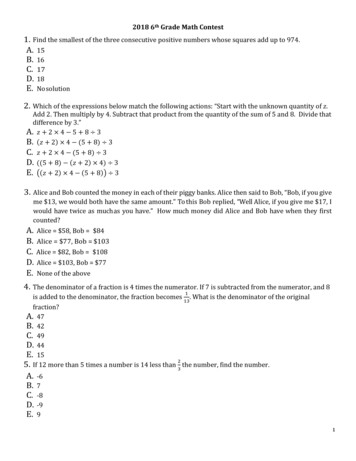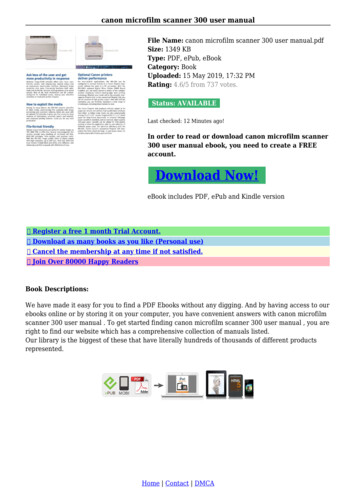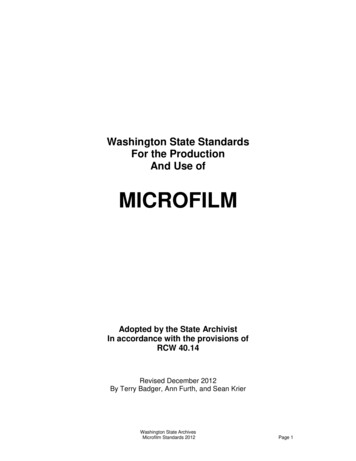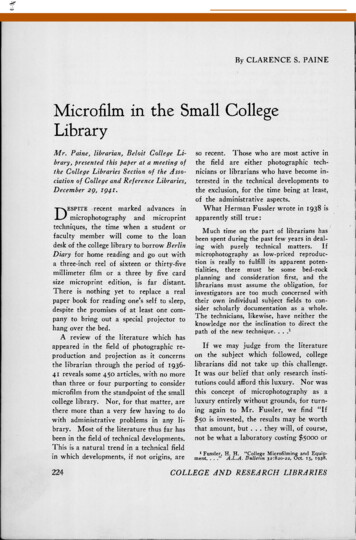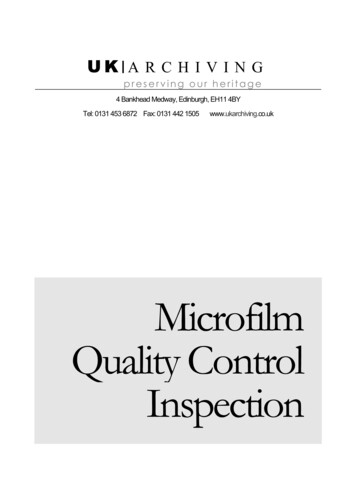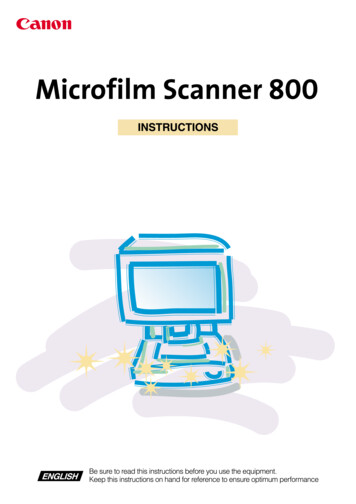
Transcription
View metadata, citation and similar papers at core.ac.ukbrought to you byCOREprovided by Illinois Digital Environment for Access to Learning and.We Chose MicrofilmBy FRANCES L. MEALS and W A L T E R T . J O H N S O Nmade of a selected group ofjunior college libraries in 1958,1 itwas discovered that only two of theseventy-nine libraries surveyed were using microfilm to any extent as a meansof preserving periodicals. T h e survey didreveal much interest in periodicals onmicrofilm by librarians who would liketo use microfilm or who were consideringusing it.Because of this interest the librariansof the two junior college libraries—Abraham Baldwin and Colby—using microfilm to preserve periodicals felt that theirexperience with this medium might beof value to others.Colby Junior College began usingmicrofilm in 1952, and Abraham Baldwin College began in 1956. Each receivestwenty-eight titles on microfilm and bothpurchase the completed films from commercial suppliers rather than attempting to process their own.Baldwin's back periodical file was invery poor shape in 1955. Few items hadbeen bound professionally and back periodicals were kept in home-made binders, in pamphlet boxes, or just tied up.That a binding program needed to bestarted was increasingly evident, butsince the Baldwin Library was in needof space, there was no room to store thebound items properly. In going throughthe periodicals selected for possible binding, Baldwin discovered that there weremany missing issues which would haveto be replaced and thus add to the binding expense.Colby had a back file of bound periodicals and had moved into a new buildN A SURVEYI1 Henrietta Thomae and W. T. Johnston, " A Surveyof a Selected Group of Tunior College Libraries" (Mimeographed, 1958). Partially published as " A Glance atTunior College Libraries," The Junior CollegeJournal,X X I X (1958), 195-202.MAY1960Miss Mealsis Librarian,Colby JuniorCollege, New London,N. H., and Mr.Johnsonis Librarian,AbrahamBaldwinCollege,Tifton,Ga.ing in 1950 so that space was not an immediate problem, although the cost ofbuilding had made Colby well aware ofthe need to conserve space. Colby wasbothered by the proverbial missing issues at binding time and had also hadthe sad experience of some articles beingclipped from volumes already bound.Thus the problem of space led bothColby and Baldwin to consider microfilm, and that was the primary reasonthat both chose to preserve back issues ofperiodicals on microfilm.T h e space-saving possibilities of microfilm in actual practice come as something of a shock even after one has seenthe promotion pictures of a bound periodical together with a reel of microfilmof the same volume showing the reduction in size. A nine-drawer microfilmcabinet using 16.2 cubic feet of spacewill hold 540 reels of microfilm or some725 periodical volumes, since many titlescome two volumes, or twelve months ofissues, to the reel. Regular ten-inchdouble-faced stack shelving would require 123.7 cubic feet or seven and ahalf times as much space to hold thesame number of volumes. On a squarefootage basis, the difference is not sogreat as Figure 1 indicates.T h e missing and mutilated issuesproblem wras the second reason that bothelected to use microfilm. Since the microfilm is supplied in finished form by acommercial firm, one does not have theproblem of finding a missing issue tocomplete a volume. T o date, neither has223
had an article clipped f r o m a reel ofmicrofilm, and this seems to be a ratherremote possibility since the student doesnot possess a film reader.Colby and Baldwin both consideredthe cost of microfilm versus binding.Microfilm runs about one-fourth centper page; therefore, the thicker the magazine, the higher the cost. Binding isgenerally priced according to the heightof the magazine with the taller ones costing the most to bind. T a b l e 1 gives arough comparison of binding and microfilm costs for five magazines of variousthicknesses and heights. T h i s comparison indicates that binding is slightlycheaper. In actual practice, Baldwin andColby have f o u n d that the base price ofbinding and microfilm for the numberof titles each receives works out aboutthe same, with microfilm being slightlycheaper. T h e extras—to borrow an automotive term—are what make the difference. N o extras are involved with microfilm except writing and mailing theorder, and a one-time standing order canbe made. Binding involves several extras: periodicals must be collated andtied; missing and mutilated issues mustbe secured through purchase or exchange; periodicals must be packed forshipment to the bindery and unpackedon return; and transportation must bepaid on smaller shipments. These extrascost in staff time if not in money.T h e biggest drawback Baldwin andColby faced in starting a microfilm program was the initial cost. Microfilmreaders run f r o m 125 up, with 350being the price of one of the better ones.Humidified storage cabinets start at 186, although less adequate storageboxes for a few reels of film can be purchased for a few dollars. One might figure an initial outlay of 500 for onereader and one humidified storage cabinet. A t Baldwin the space-saving featurewas used in presenting the budget request for the extra 500 necessary tocover the initial equipment cost.Baldwin's need for a larger librarybuilding is acute. In 1952 part of theFigure 1Comparison of floor space required for storageof bound and microfilmed periodicals.BOUND PERIODICAL STORAGE SPACE: 40.5 square feetMICROFILMED PERIODICAL STORAGE SPACE: 8.87 square feetScale:224COLLEGEANDRESEARCHi" 1LIBRARIES
TABLE1COMPARISON OF B I N D I N G AND M I C R O F I L M COSTSPERIODICALReader'sDigestScience DigestChangingTimesU. S. News andWorld ReportHouse and GardenISSUED12 MONTHSBOUND AS1 2 MONTHSFILMED ASMonthlyMonthlyMonthly2 vols.2 vols.1 vol.1 reel1 reel1 reelWeeklyMonthly4 vols.2 vols.2 reels1 reelTOTALBINDING COSTFOR ONE Y E A R *MICROFILM COSTFOR ONE Y E A R F 6.586.583.59 7.453.502.0015.368.26 40.3721.086.97 41.00* Average of prices of three binderies (excluding transportation charges),f Average of three years 1955 through 1957 (including postage charges).workroom was given over to periodicalstorage and in 1954 a small nook wasre-partitioned from reading room areato periodical storage area. It was correctly anticipated that microfilm wouldprevent the necessity of borrowing periodical storage area from another floorarea for several years. Of course, thepoint was made to the librarian that aneventual new building would solve spaceproblems. T o answer this argumentagainst the high initial cost of microfilmequipment one can present figures onspace costs. Using Figure 1 as a basis,40.5 square feet of floor space for thestorage of b o u n d periodicals will cost atleast 445.50 if one uses the low building cost of eleven dollars per squarefoot. T o this must be added about 175 for nine feet of double-faced teninch library-type shelving. Comparedwith this, the space for the microfilmstorage cabinet will cost 97.57 ateleven dollars per square foot, but thespace above the fifty-inch high microfilm cabinet can be used for some storage. A d d i n g 500 initial equipment outlay to this gives a figure of 597.57 formicrofilm storage, compared to 620.50for conventional storage. If the cost ofthe film reader is omitted, the cost ofcomparable microfilm storage drops to 283.57. Figure 2 shows this in diagramform. O n e might even go so far as toadd something for heating, cooling,MAY1960lighting, and maintaining the largerspace required for conventional periodical storage. Consequently, microfilmeither means less space needed in a newbuilding or more space for other purposes.Baldwin and Colby each elected to secure twenty-eight titles on microfilm although each takes many more periodicals than this. T h e selection was madeon the basis of whether or not the publication was indexed in theReaders'Guide and how frequently back issueswere called for in the library. There islittle similarity between the microfilmlists of the two libraries. Colby also receives the New York Times on microfilm.Since Baldwin had only a small collectionof b o u n d periodicals, it has purchasedmany back reels to try to complete certain holdings from 1950 on.In selecting equipment, both chosenine drawer humidified film cabinetswhich are filing-cabinet height. A sixdrawer cabinet, which is table-top heightand so permits the film reader to beplaced on top, is available, but the ninedrawer cabinet provides more storagespace per dollar of cost.Colby elected to purchase one of themore expensive readers (about 350 list).Baldwin chose to buy two cheaper filmreaders (about 125 each) in order toaccommodate two users at once. Baldwinfeels that in selecting two of the cheaper225
Figure 2Comparison of cost for storageof bound and microfilmed periodicalsBOUND(725 v's.)MICROFILMEP(725 v's.)Cost of floor space at 11 per squareCost of shelving orfoot.cabinet.Cost of reader (necessary for use, butfor storage of m i c r o f i l m ) .notreaders instead of one more expensivereader it erred because the expensivereaders have more refinements whichmake them easier to use and less likelyto scratch film and they also offer slightlygreater magnification. T h e two readershave prevented waiting at times, butBaldwin could easily have gotten bywith one reader about 90 per cent of thetime, although the second reader is currently receiving much more usage. Colbypresently feels the need for a secondreader. Both discovered that the readermay be placed anywhere in the library,although the best location is a spotwhere the room light is about the samebrightness as the light projected by thereader and the user does not look upfrom the reader to face a window.Colby plans to revamp its serial cataloging and so has not yet listed its microfilm holdings in its public catalog. Baldwin lists its periodical holdings on cardsin a catalog drawer marked "Periodi226cals." T o list periodicals held, Baldwinuses a card bearing volume numbers andthe notation "Library has those volumeswhich are dated." O n the card in callnumber position the symbol PB is usedto indicate "Periodicals B o u n d " andP M F is used to indicate "Periodicals onMicrofilm." W h e r e both b o u n d andmicrofilm volumes of a title are held,two cards are used with PB items on oneand P M F items on the second. T h i sworks well for Baldwin since all b o u n dvolumes are older than the microfilmedissues.Colby follows its open-shelf policy inconnection with its microfilm holdings,and a student may go directly to the file,select the film she needs, and use thereader. Because of its building arrangement and the location of its microfilmstorage, Baldwin does not apply its openstack policy to microfilm, and the student must ask the librarian for film. AtBaldwin, in the event the readers are inuse, the student fills a request card andis scheduled to use the reader at anothertime convenient to him. Both Colby andBaldwin instruct the student in how touse the film reader for the first time andcheck o n his next use to see that he isdoing it correctly. Neither attempts togive group instruction in the use of thereader.T h e disadvantages of microfilm appear to be few. Perhaps the complaintmost often heard is made by those looking for articles on interior decoration,clothing design, travel, etc., for microfilm is black and white and thus coloris lost. N o t all periodicals are availableon microfilm from commercial suppliers,but 78 per cent of the titles indexed inReaders'Guide to PeriodicalLiteraturecan be obtained on microfilm, and Baldwin and Colby have f o u n d this sufficientfor their needs.Microfilm is usually supplied anywhere from several weeks to severalmonths after the periodical year is com(ContinuedCOLLEGEANDon page 228)RESEARCHLIBRARIES
have seen the subscription totals of all ofthe journals increase sharply; all butone are well over the five-hundred mark.T h e Soviet Physics—JETPsubscriptionlist n o w approximates one-thousand.Subscription prices now range f r o m approximately one to two and one-halfcents per page, nonprofit academic libraries taking the lower rate.W h e n related to the benefits of theprogram, the cover-to-cover translationjournals are viewed as a relatively inexpensive means of acquiring the resultsof much valuable research. In absoluteterms, of course, the program is not without its cost. But until such time as aknowledge of Russian is much morewidespread or until machine translationis perfected, the most effective methodof communicating Soviet developmentsto the West would appear to be by thedelivery to the scientist, five to sevenmonths after publication of the originals,the authoritative, complete translations.T h e rising use of the latter points to afirm acceptance of the present translation program by the physicist and the research librarian w h o serves him.We Chose Microfilm(Continuedfrompage226)plete. Since the paper issues are not sentaway for processing as in binding, thelibrary always has a complete file available for use. Both the Colby and Baldwin libraries dispose of the magazineswhich have been replaced by microfilm.In comparing notes, Colby and Baldwin agree on the advantages and disadvantages of microfilm except for oneitem. Colby feels that films are easier touse since one does not have to handleweighty volumes of periodicals. Baldwinconsiders b o u n d volumes slightly easierto use since the librarian does not haveto give instructions in film reader operation and since a page is easier to findthan a frame of microfilm. T o see theframe-finding problem, one must realizethat microfilm is stored on hundred-footreels which accommodate twelve issuesof monthly magazines, and in usingmicrofilm one always starts at the frontof the reel. For example, if the November issue is wanted, one must reelthrough January, February, March, etc.,to reach November. T h e experiencedmicrofilm reader soon learns to "watchfor the cover," which is a single pageframe causing a light flick and enablingone to count months while winding filmat a rapid rate, and so find the rightmonth with a m i n i m u m of time; but frequently the beginning microfilm usercomplains that it takes him several minutes to find the right frame. However,Baldwin considers this a minor complaint.228COLLEGEO n e unexpected advantage that cameto Baldwin and Colby from their microfilm programs is that both are able toprovide microfilm readers for facultyand non-college personnel borrowing orbuying microfilm materials in connection with research or graduate study.Colby feels that this has made many offcampus people friends of its library.T h e librarians of Baldwin and Colbyare pleased with the space and moneysaving features of microfilm and considerit an excellent solution to many problems involved in keeping and in usingback issues of periodicals, especially inthe small library which is limited inspace, staff, and funds. Most studentsare intrigued by microfilm and delight infinding opportunities to use it.ANDRESEARCHLIBRARIES
to use microfilm or who were considering using it. Because of this interest the librarians of the two junior college libraries—Abra-ham Baldwin and Colby—using micro-film to preserve periodicals felt that their experience with this medium might be of value to others. Colby Junior College began using microfilm in 1952, and Abraham Bald-win College began in 1956. Each receives twenty-eight .
